HRM Case Study: Discrimination and Workplace Harassment Analysis
VerifiedAdded on 2022/08/17
|6
|1033
|15
Case Study
AI Summary
This assignment provides a comprehensive analysis of two HRM case studies. The first case examines potential systemic discrimination against a disabled job applicant, Rowina, within the context of Canadian human rights law. The analysis delves into the decisions made by the department manager and supervisor, considering their justifications while also highlighting the potential for a more inclusive approach. The second case explores workplace harassment involving Alison, who faced gender-based harassment and subsequent termination due to her gender transformation. The assignment critically evaluates the company's actions from a humanistic perspective, emphasizing the importance of strong leadership, comprehensive initiatives, and a supportive work environment to prevent similar situations. The analysis concludes with actionable recommendations for fostering a diverse and respectful workplace, including training, technological support, and open communication.
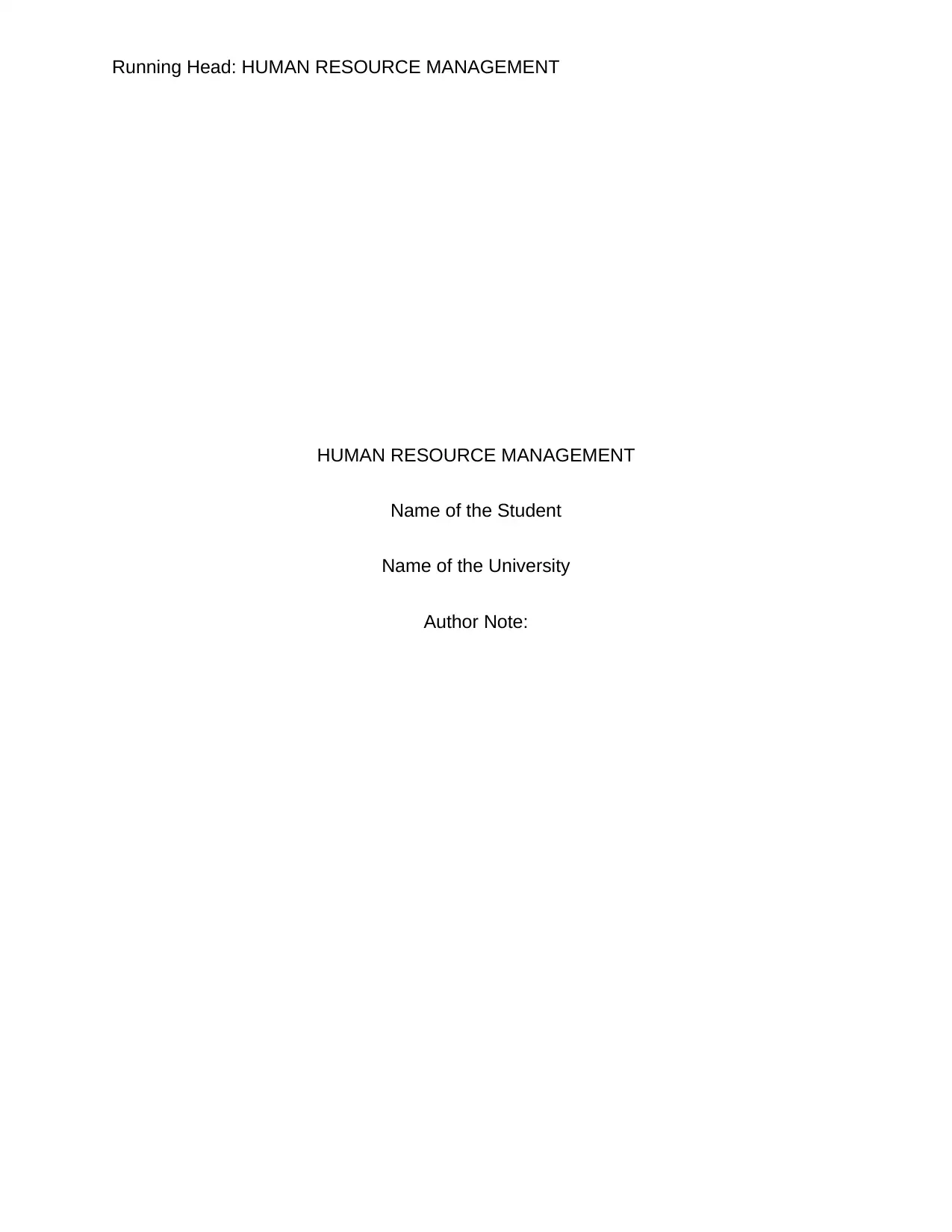
Running Head: HUMAN RESOURCE MANAGEMENT
HUMAN RESOURCE MANAGEMENT
Name of the Student
Name of the University
Author Note:
HUMAN RESOURCE MANAGEMENT
Name of the Student
Name of the University
Author Note:
Paraphrase This Document
Need a fresh take? Get an instant paraphrase of this document with our AI Paraphraser
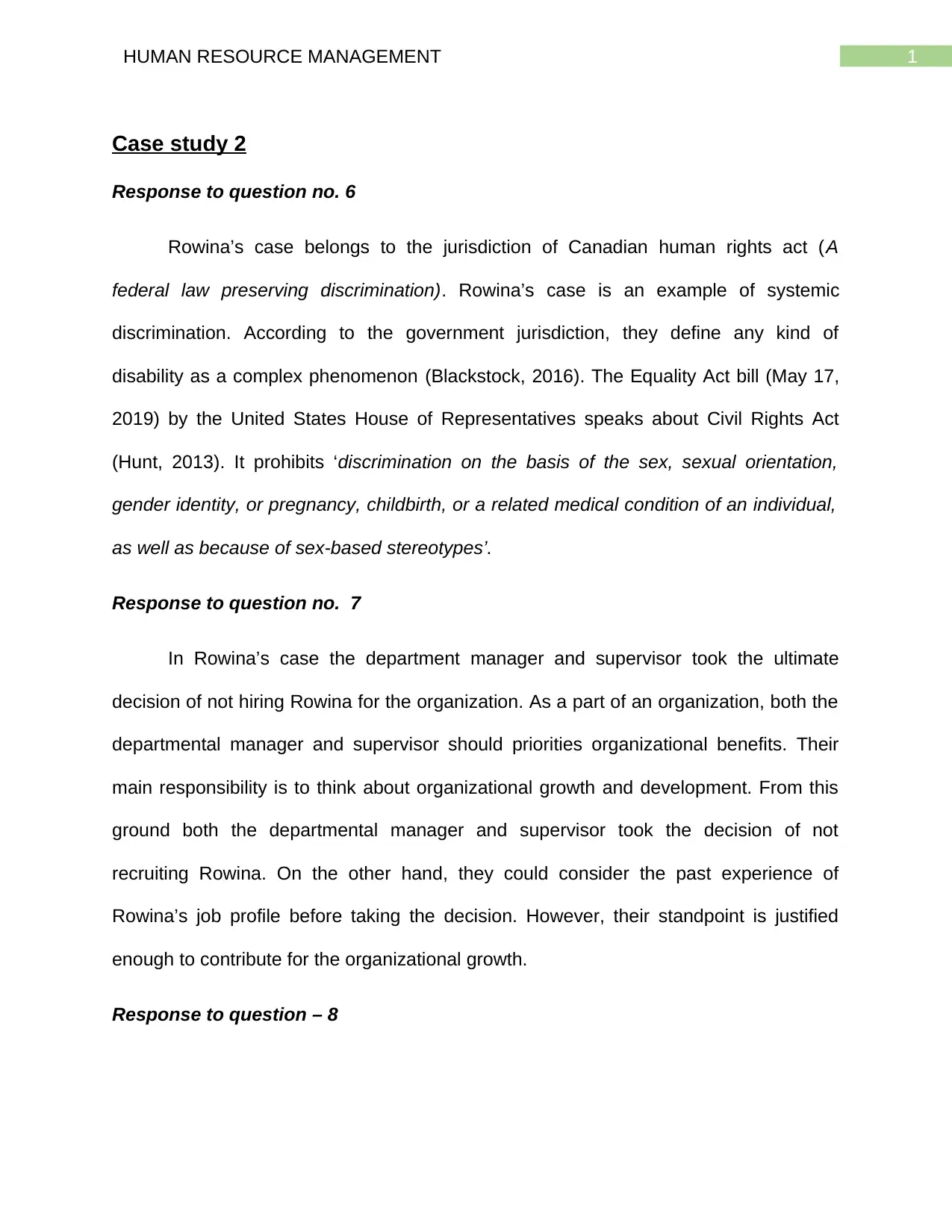
1HUMAN RESOURCE MANAGEMENT
Case study 2
Response to question no. 6
Rowina’s case belongs to the jurisdiction of Canadian human rights act (A
federal law preserving discrimination). Rowina’s case is an example of systemic
discrimination. According to the government jurisdiction, they define any kind of
disability as a complex phenomenon (Blackstock, 2016). The Equality Act bill (May 17,
2019) by the United States House of Representatives speaks about Civil Rights Act
(Hunt, 2013). It prohibits ‘discrimination on the basis of the sex, sexual orientation,
gender identity, or pregnancy, childbirth, or a related medical condition of an individual,
as well as because of sex-based stereotypes’.
Response to question no. 7
In Rowina’s case the department manager and supervisor took the ultimate
decision of not hiring Rowina for the organization. As a part of an organization, both the
departmental manager and supervisor should priorities organizational benefits. Their
main responsibility is to think about organizational growth and development. From this
ground both the departmental manager and supervisor took the decision of not
recruiting Rowina. On the other hand, they could consider the past experience of
Rowina’s job profile before taking the decision. However, their standpoint is justified
enough to contribute for the organizational growth.
Response to question – 8
Case study 2
Response to question no. 6
Rowina’s case belongs to the jurisdiction of Canadian human rights act (A
federal law preserving discrimination). Rowina’s case is an example of systemic
discrimination. According to the government jurisdiction, they define any kind of
disability as a complex phenomenon (Blackstock, 2016). The Equality Act bill (May 17,
2019) by the United States House of Representatives speaks about Civil Rights Act
(Hunt, 2013). It prohibits ‘discrimination on the basis of the sex, sexual orientation,
gender identity, or pregnancy, childbirth, or a related medical condition of an individual,
as well as because of sex-based stereotypes’.
Response to question no. 7
In Rowina’s case the department manager and supervisor took the ultimate
decision of not hiring Rowina for the organization. As a part of an organization, both the
departmental manager and supervisor should priorities organizational benefits. Their
main responsibility is to think about organizational growth and development. From this
ground both the departmental manager and supervisor took the decision of not
recruiting Rowina. On the other hand, they could consider the past experience of
Rowina’s job profile before taking the decision. However, their standpoint is justified
enough to contribute for the organizational growth.
Response to question – 8
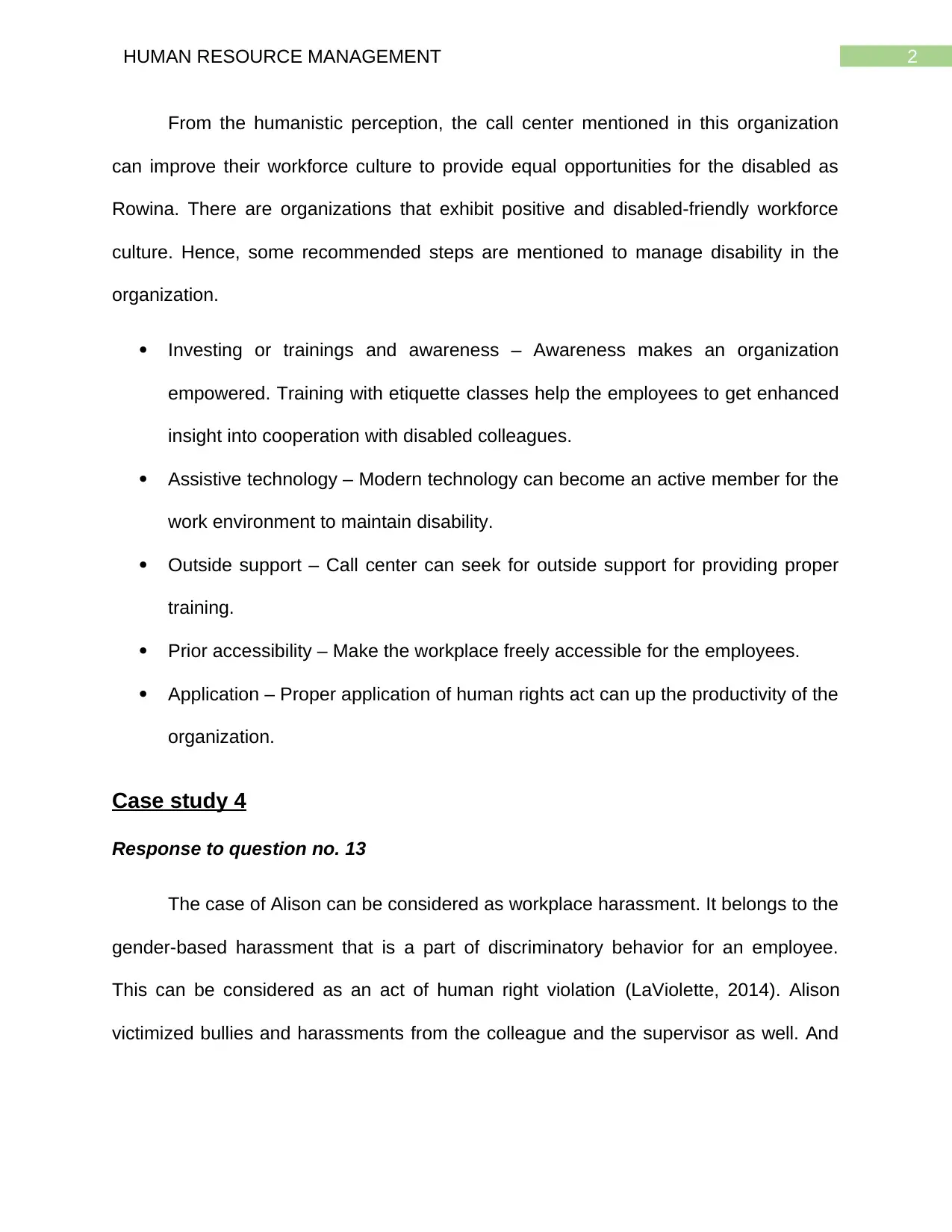
2HUMAN RESOURCE MANAGEMENT
From the humanistic perception, the call center mentioned in this organization
can improve their workforce culture to provide equal opportunities for the disabled as
Rowina. There are organizations that exhibit positive and disabled-friendly workforce
culture. Hence, some recommended steps are mentioned to manage disability in the
organization.
Investing or trainings and awareness – Awareness makes an organization
empowered. Training with etiquette classes help the employees to get enhanced
insight into cooperation with disabled colleagues.
Assistive technology – Modern technology can become an active member for the
work environment to maintain disability.
Outside support – Call center can seek for outside support for providing proper
training.
Prior accessibility – Make the workplace freely accessible for the employees.
Application – Proper application of human rights act can up the productivity of the
organization.
Case study 4
Response to question no. 13
The case of Alison can be considered as workplace harassment. It belongs to the
gender-based harassment that is a part of discriminatory behavior for an employee.
This can be considered as an act of human right violation (LaViolette, 2014). Alison
victimized bullies and harassments from the colleague and the supervisor as well. And
From the humanistic perception, the call center mentioned in this organization
can improve their workforce culture to provide equal opportunities for the disabled as
Rowina. There are organizations that exhibit positive and disabled-friendly workforce
culture. Hence, some recommended steps are mentioned to manage disability in the
organization.
Investing or trainings and awareness – Awareness makes an organization
empowered. Training with etiquette classes help the employees to get enhanced
insight into cooperation with disabled colleagues.
Assistive technology – Modern technology can become an active member for the
work environment to maintain disability.
Outside support – Call center can seek for outside support for providing proper
training.
Prior accessibility – Make the workplace freely accessible for the employees.
Application – Proper application of human rights act can up the productivity of the
organization.
Case study 4
Response to question no. 13
The case of Alison can be considered as workplace harassment. It belongs to the
gender-based harassment that is a part of discriminatory behavior for an employee.
This can be considered as an act of human right violation (LaViolette, 2014). Alison
victimized bullies and harassments from the colleague and the supervisor as well. And
⊘ This is a preview!⊘
Do you want full access?
Subscribe today to unlock all pages.

Trusted by 1+ million students worldwide
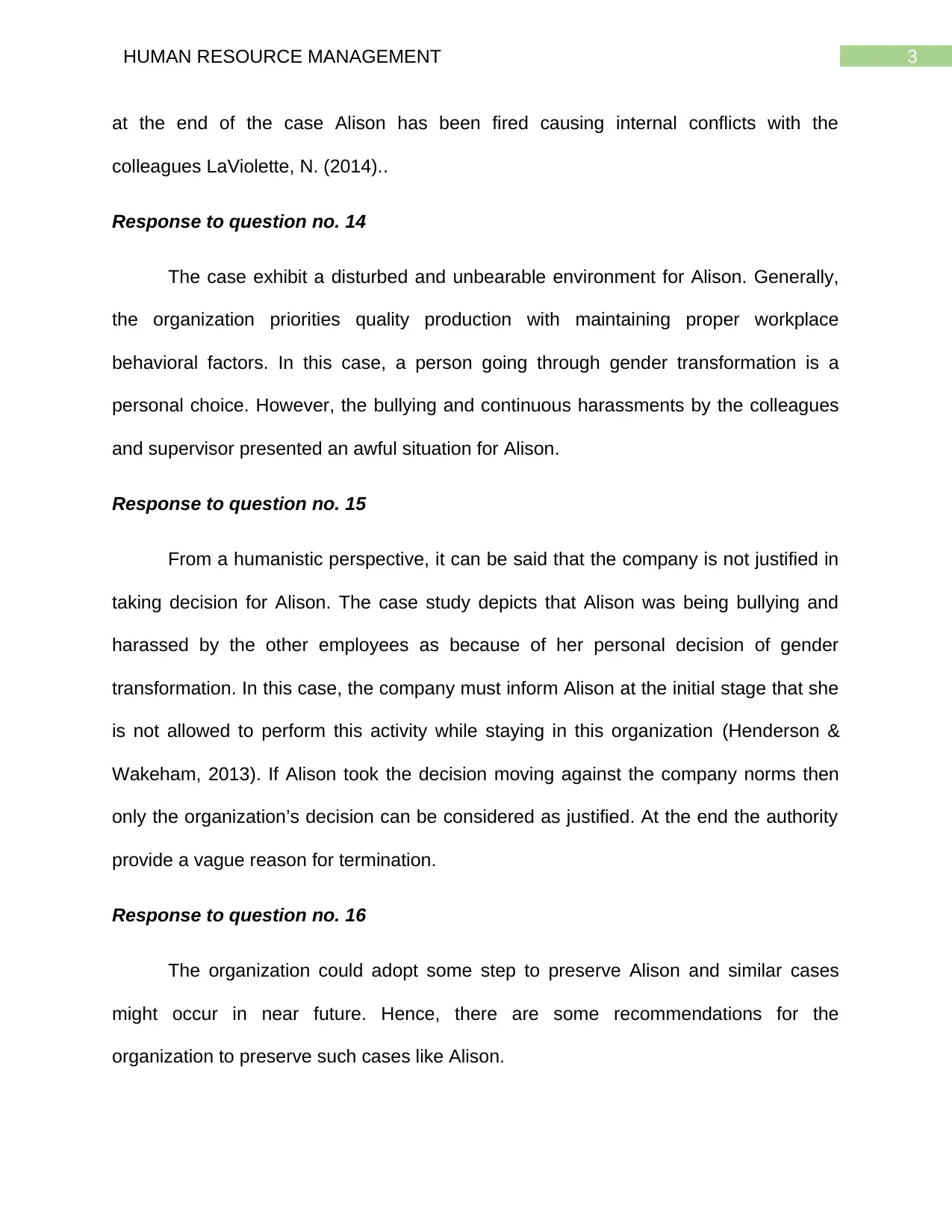
3HUMAN RESOURCE MANAGEMENT
at the end of the case Alison has been fired causing internal conflicts with the
colleagues LaViolette, N. (2014)..
Response to question no. 14
The case exhibit a disturbed and unbearable environment for Alison. Generally,
the organization priorities quality production with maintaining proper workplace
behavioral factors. In this case, a person going through gender transformation is a
personal choice. However, the bullying and continuous harassments by the colleagues
and supervisor presented an awful situation for Alison.
Response to question no. 15
From a humanistic perspective, it can be said that the company is not justified in
taking decision for Alison. The case study depicts that Alison was being bullying and
harassed by the other employees as because of her personal decision of gender
transformation. In this case, the company must inform Alison at the initial stage that she
is not allowed to perform this activity while staying in this organization (Henderson &
Wakeham, 2013). If Alison took the decision moving against the company norms then
only the organization’s decision can be considered as justified. At the end the authority
provide a vague reason for termination.
Response to question no. 16
The organization could adopt some step to preserve Alison and similar cases
might occur in near future. Hence, there are some recommendations for the
organization to preserve such cases like Alison.
at the end of the case Alison has been fired causing internal conflicts with the
colleagues LaViolette, N. (2014)..
Response to question no. 14
The case exhibit a disturbed and unbearable environment for Alison. Generally,
the organization priorities quality production with maintaining proper workplace
behavioral factors. In this case, a person going through gender transformation is a
personal choice. However, the bullying and continuous harassments by the colleagues
and supervisor presented an awful situation for Alison.
Response to question no. 15
From a humanistic perspective, it can be said that the company is not justified in
taking decision for Alison. The case study depicts that Alison was being bullying and
harassed by the other employees as because of her personal decision of gender
transformation. In this case, the company must inform Alison at the initial stage that she
is not allowed to perform this activity while staying in this organization (Henderson &
Wakeham, 2013). If Alison took the decision moving against the company norms then
only the organization’s decision can be considered as justified. At the end the authority
provide a vague reason for termination.
Response to question no. 16
The organization could adopt some step to preserve Alison and similar cases
might occur in near future. Hence, there are some recommendations for the
organization to preserve such cases like Alison.
Paraphrase This Document
Need a fresh take? Get an instant paraphrase of this document with our AI Paraphraser
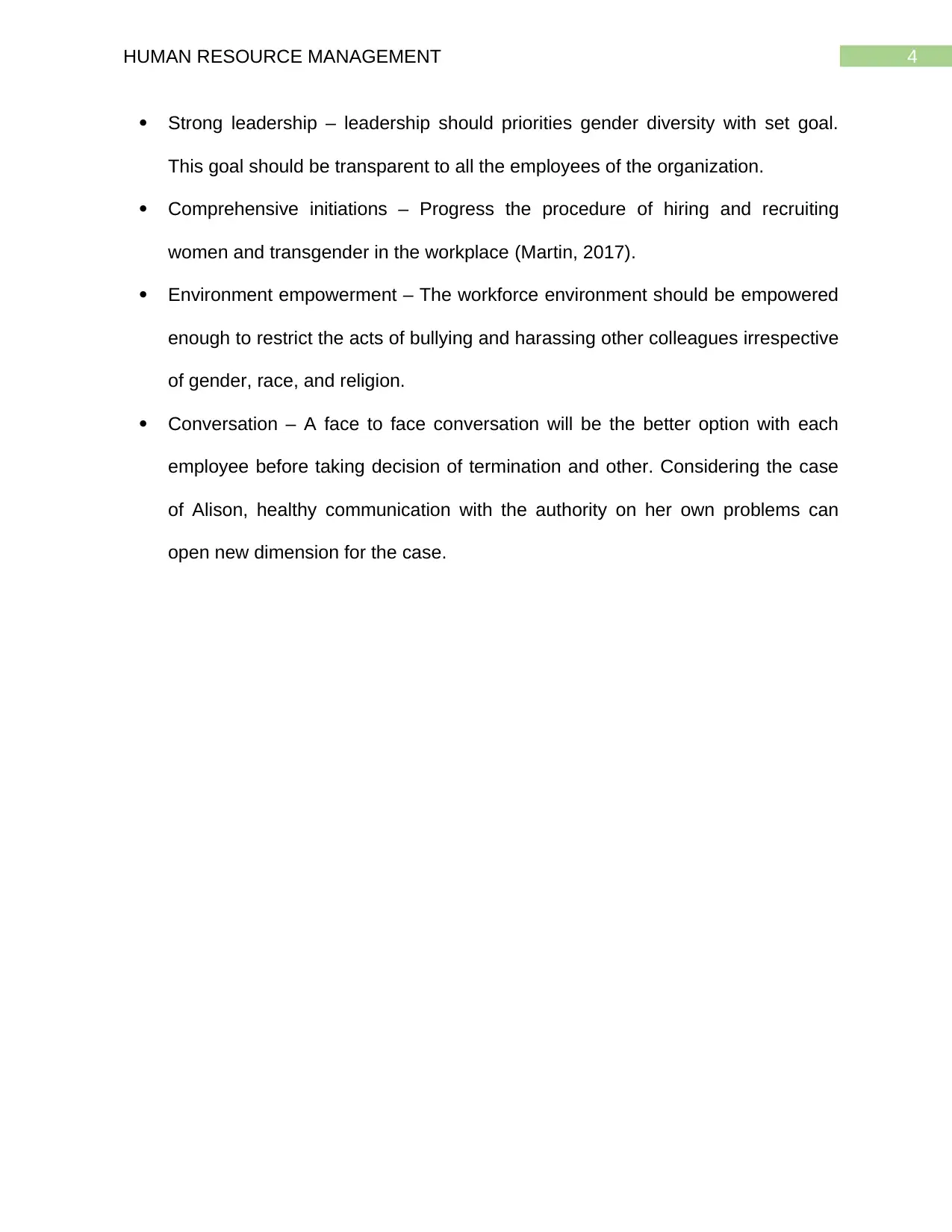
4HUMAN RESOURCE MANAGEMENT
Strong leadership – leadership should priorities gender diversity with set goal.
This goal should be transparent to all the employees of the organization.
Comprehensive initiations – Progress the procedure of hiring and recruiting
women and transgender in the workplace (Martin, 2017).
Environment empowerment – The workforce environment should be empowered
enough to restrict the acts of bullying and harassing other colleagues irrespective
of gender, race, and religion.
Conversation – A face to face conversation will be the better option with each
employee before taking decision of termination and other. Considering the case
of Alison, healthy communication with the authority on her own problems can
open new dimension for the case.
Strong leadership – leadership should priorities gender diversity with set goal.
This goal should be transparent to all the employees of the organization.
Comprehensive initiations – Progress the procedure of hiring and recruiting
women and transgender in the workplace (Martin, 2017).
Environment empowerment – The workforce environment should be empowered
enough to restrict the acts of bullying and harassing other colleagues irrespective
of gender, race, and religion.
Conversation – A face to face conversation will be the better option with each
employee before taking decision of termination and other. Considering the case
of Alison, healthy communication with the authority on her own problems can
open new dimension for the case.
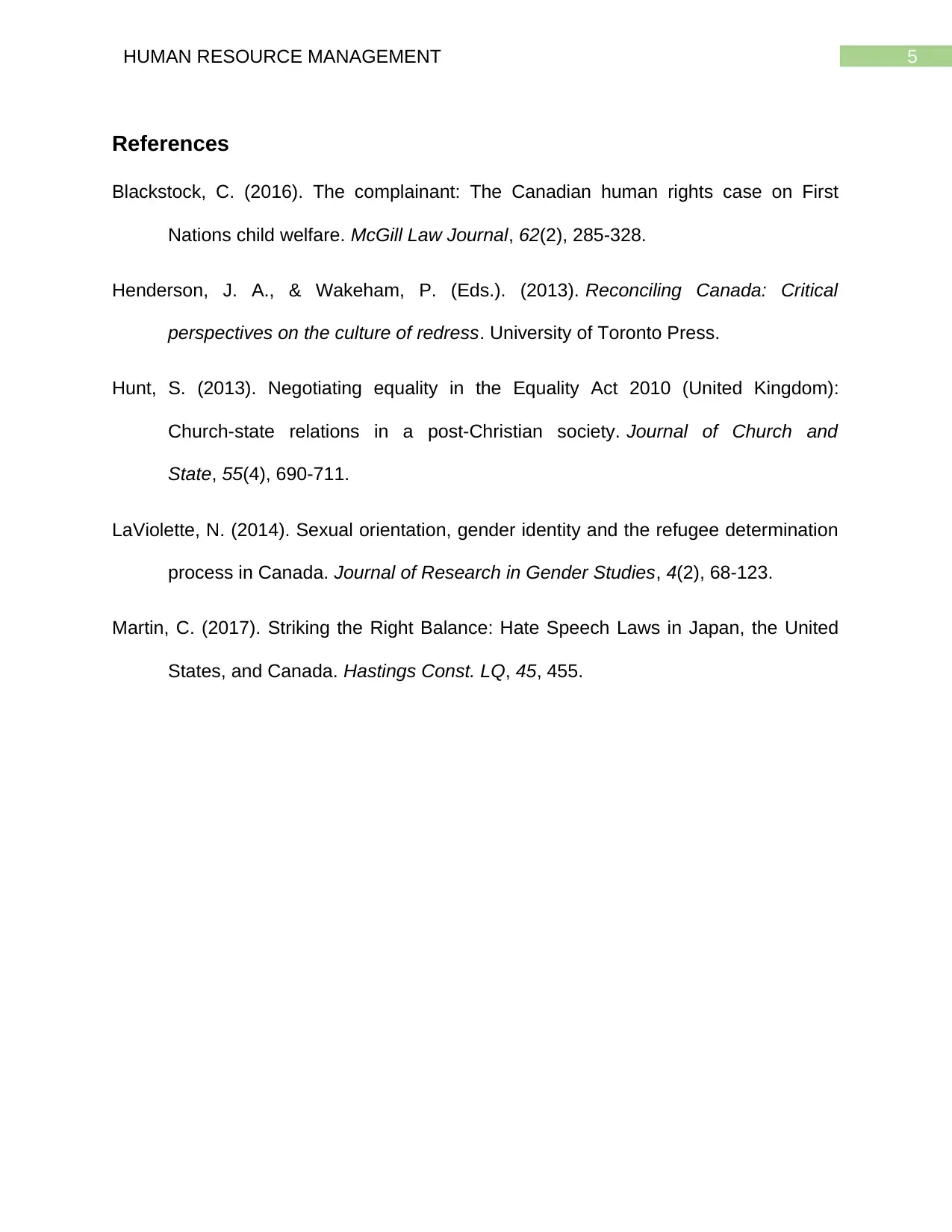
5HUMAN RESOURCE MANAGEMENT
References
Blackstock, C. (2016). The complainant: The Canadian human rights case on First
Nations child welfare. McGill Law Journal, 62(2), 285-328.
Henderson, J. A., & Wakeham, P. (Eds.). (2013). Reconciling Canada: Critical
perspectives on the culture of redress. University of Toronto Press.
Hunt, S. (2013). Negotiating equality in the Equality Act 2010 (United Kingdom):
Church-state relations in a post-Christian society. Journal of Church and
State, 55(4), 690-711.
LaViolette, N. (2014). Sexual orientation, gender identity and the refugee determination
process in Canada. Journal of Research in Gender Studies, 4(2), 68-123.
Martin, C. (2017). Striking the Right Balance: Hate Speech Laws in Japan, the United
States, and Canada. Hastings Const. LQ, 45, 455.
References
Blackstock, C. (2016). The complainant: The Canadian human rights case on First
Nations child welfare. McGill Law Journal, 62(2), 285-328.
Henderson, J. A., & Wakeham, P. (Eds.). (2013). Reconciling Canada: Critical
perspectives on the culture of redress. University of Toronto Press.
Hunt, S. (2013). Negotiating equality in the Equality Act 2010 (United Kingdom):
Church-state relations in a post-Christian society. Journal of Church and
State, 55(4), 690-711.
LaViolette, N. (2014). Sexual orientation, gender identity and the refugee determination
process in Canada. Journal of Research in Gender Studies, 4(2), 68-123.
Martin, C. (2017). Striking the Right Balance: Hate Speech Laws in Japan, the United
States, and Canada. Hastings Const. LQ, 45, 455.
⊘ This is a preview!⊘
Do you want full access?
Subscribe today to unlock all pages.

Trusted by 1+ million students worldwide
1 out of 6
Related Documents
Your All-in-One AI-Powered Toolkit for Academic Success.
+13062052269
info@desklib.com
Available 24*7 on WhatsApp / Email
![[object Object]](/_next/static/media/star-bottom.7253800d.svg)
Unlock your academic potential
Copyright © 2020–2025 A2Z Services. All Rights Reserved. Developed and managed by ZUCOL.





